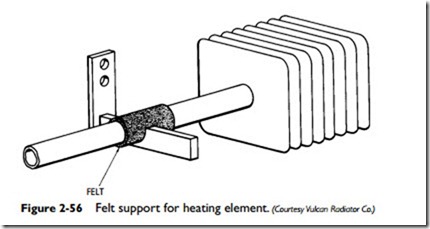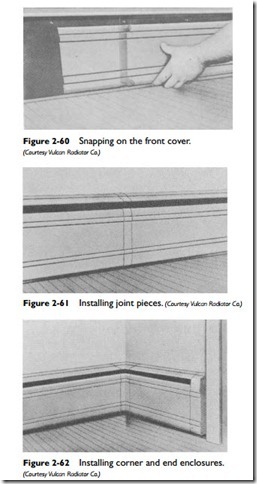Installing Baseboard Units
A steel fin-and-tube baseboard heating element will expand as much as 1⁄8 inch per 10 feet with a 70°F to 200°F temperature rise.
A copper element will expand as much as 1⁄16 inch per 10 feet under the same conditions. This potential expansion of the heating element must be provided for when installing the system or problems will arise. The following provisions are recommended:
1. Allow a clearance of at least 1⁄4 inch around all piping that passes through floors or wall partitions.
2. Wrap pipe passing through a floor or wall partition with a felt or foam sleeve to act as a cushion (see Figure 2-53).
3. Try to limit straight runs of pipe to a maximum of 30 feet.
Wherever longer runs are necessary, install a bellows-type expansion joint near the center and anchor the ends.
4. Where a baseboard system extends around a corner, provide extra clearance at the ends (expansion will generally occur away from the corner) (see Figure 2-54).
5. When a baseboard system is installed around three adjacent walls (forming a U), always use an expansion joint in the center leg of the U (see Figure 2-55).
6. When making piping connections, be sure to keep all radiator elements in proper vertical position so that fin edges will not touch other metal parts.
Extra clearance with felt or foam sleeve wrapped around the pipe.
7. Be sure to support all mains and other piping runs adequately so that their weight will not cause bowing of the heating elements.
8. Install a felt sleeve around the pipe where it rests against a rigid hanging strap (see Figure 2-56).
Before installing the baseboard heater, check the walls carefully for straightness. The baseboard heaters must be absolutely straight or their operating efficiency will be reduced. Therefore, it would be a mistake to use a wall to align the units if the wall were not straight.
Shims may have to be used on wavy walls to keep the baseboard sys- tem straight.
Many baseboard heaters can be recessed the depth of the plaster. The back of each unit is nailed to the studs before plastering, and the top of the baseboard heater hood serves as a plaster stop. The top accessories must be installed before plastering.
The procedure for installing a steam or hot-water baseboard heating system may be summarized as follows:
1. Place the backing of the unit against the wall surface or studs (in a recessed installation) and mark the location of the studs (see Figure 2-57).
2. Punch holes in the backing and screw it to the studs.
3. Install cover support brackets approximately 3 feet apart (see Figure 2-58).
4. Place cradle hangers on rivet head and set the heating element on the cradles, making sure the fins are vertical and that all hangers are free to swing (see Figure 2-59).
5. Complete piping and test for leaks before snapping on the fronts.
6. Snap the front cover onto the support brackets by hooking the top lip over the upper arms and snapping the bottom lip over the bottom arms (see Figure 2-60).
7. Add joining pieces and end enclosures where appropriate (see Figures 2-61 and 2-62).
Hot-water heating systems can be divided by temperature into the following three types:
1. High-temperature water systems, 350°F to 450°F.
2. Medium-temperature water systems, 250°F to 350°F.
3. Low-temperature water systems, below 250°F.
Although low-temperature hot-water heating systems are the pre- dominant type used in the United States, there is a growing tendency to apply high-temperature water not only to underground distribution piping (as in district heating) but also to direct radiation.
When fin-tube baseboard units are used in a high-temperature hot-water heating system, care must be taken to keep the enclosure surface temperature to a minimum. This can be accomplished as follows:
1. Use the highest enclosure height practical.
2. Use heating elements only one row high.
3. Use a maximum fin spacing of 33 per foot.
4. Spread the heating element out along the entire wall length.
5. Limit the water temperature to that necessary to offset building heat loss.
Because of the higher heat level, the expansion of heating elements becomes more of a factor with high-temperature hot-water heating systems. As a result, more expansion joints should be used along the length of the heating elements than is the case with low- temperature water.
Baseboard Heater Maintenance
The baseboard heaters used in steam or hot-water heating systems must be routinely cleaned and vacuumed to ensure that the convective fins are clean. If the fins are covered with a layer of dust or dirt, it will impede the radiation of heat into the room or space. Remove the baseboard cover at least once every two months to check the cleanliness of the fins.





